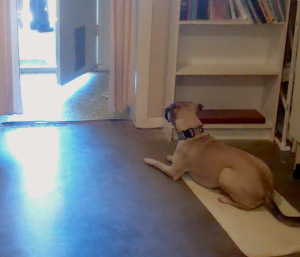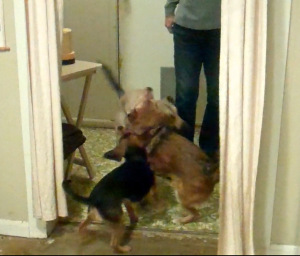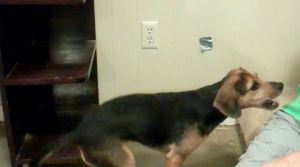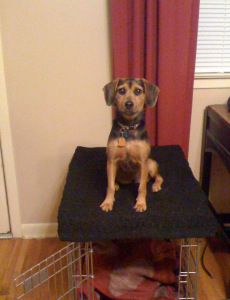Barks Blog
Eight Common Dog Training Errors: Cautionary Tales
As the great trainer Bob Bailey says, training is simple but not easy. The principles are very simple and straightforward, but actually applying them in practice can be very difficult.
I’ve mentioned many times that I am not a professional trainer. But I hang out with some phenomenal ones. Plus, I am a student of life and tend to do lots of observation of myself and others. (What, you had noticed?) And I don’t mind sharing my own errors if it can help somebody along.
Here are eight of the top booboos in dog training. All of which I have done myself, and many of them on camera! (And guess what, I have 15-20 more! You can expect more posts on this if people enjoy this one.)
And by the way, these are errors made by trainers who are using the most humane methods they know and can learn. The list would be much different if it addressed mistakes made by trainers who make heavy use of aversives. I don’t want to write that list right now!
What Can Go Wrong?
(1) Allowing the dog to rehearse the behavior you’re trying to eliminate. One of my trainer friends says this is the #1 problem she runs into with her clients. A client will say, “I bought my dog a bed for his crate and he chewed it. I bought him another one and he chewed it. I bought him another one and he chewed that one, too. I’ve bought him five beds and he’s chewed them all.” That dog is getting really skilled at chewing beds, and has found a way to occupy himself in his crate.
If a dog has a problem behavior, it’s because that behavior has been reinforced. (Chewing is fun for dogs!) Usually not deliberately by us, but reinforced nonetheless. So we don’t tend to “count” it in our minds. But it’s just as if we had given the dog a cookie every time he chewed the bed, or jumped on the couch or whatever. But if we want to teach them to do something different, we also need to prevent those fun rehearsals of the “wrong” behavior and stop that reinforcement.

For example, you want to train your dog not to crowd up to the back door and rush out when you open it. That behavior is reinforced every time she does it if you immediately let her outside. When you start to teach polite door manners, you doubtless start the training with an “easier” door. You practice with an interior door, and work on the behavior you want. You reinforce with food.
But in the meantime, every time you take your dog into the back yard to potty, she continues to crowd up to the back door

and rush out when you open it. Getting outside is obviously a potent reinforcer and nothing has happened to stop that. To get the new behavior in place at the back door, you will have to prevent your dog from practicing the old one. That can be a challenge without using aversives, but can be done. With three dogs, our back door behavior is a work in progress, but those bad habits do on occasion get reinforced. And reinforcement “on occasion” is enough to keep them alive and well.
The classic example of rehearsed behaviors and conflicting reinforcers is walking on a loose leash. If you let your dog pull you, using the same gear you use when trying to teach loose leash, that behavior gets reinforced every time that pulling gets the dog where he wants to go, just as purely as if you had given him a cookie for it. That’s why trainers always tell you to cease walking the dog or at least use completely different gear if you must walk the dog, if you are simultaneously trying to teach leash manners. You are shooting yourself in the foot otherwise.

(2) Lumping. Lumping means failing to break the behavior you are trying to teach into small enough steps. For instance, you are teaching your dog to get on a mat and lie down. Your dog is beginning to understand your cue. You stand right next to the mat and give the cue. Dog lies down. You stand two feet away from the mat and give the cue. The dog goes to the mat and lies down. You put the mat in the corner of the room, go back to the center of the room with your dog, and give the cue. Your dog says, “Huh?” Lots of misunderstandings between humans and dogs could be ameliorated if we just took enough baby steps when teaching a behavior. Here is a post about lumping, with a video starring my dog Zani, who lets her disapproval of my behavior be known.

(3) Neglecting to generalize cued behaviors. Dogs are great discriminators. They notice every little thing in the environment. It’s all pertinent to them. They are not as good as we are at generalizing. And it is very very hard for us to get that through our human heads.
If a dog knows “sit” when in the kitchen facing east, she may not know it while standing on the piano bench in your front room facing north. And she almost definitely won’t know it if you lie down on the floor next to her or stand on your head before giving the cue. All along you thought she was responding to your verbal cue, but she actually was responding to the fact that she was standing in the kitchen facing east, and you have a clicker and treats, and you said a word (which turns out that it probably could have been any word). All of that was actually her cue. I have several movies showing dogs who respond incorrectly to a cue because of the human failure (um, mine) to help them generalize.
And here’s my moment to plug Sue Ailsby’s Training Levels. The Training Levels are the best training program I have ever seen to build generalization into every step.
(4) And that leads to…not knowing what the dog’s cue actually is. It may not be what we think it is. They are generally paying attention to our body language and props way more than we think. Almost all of us (border collie owners excepted, grin), think that our dogs understand verbal cues better than they actually do. I have lots of experience with this, having been blessed with two dogs who are probably less proficient than average at verbal cues. I have yet to teach them, despite many repetitions, some simple word discriminations that some breeds and individual dogs seem to pick up very fast. To really know whether your dog understands a verbal cue or not, you need not only to practice generalization, but get yourself out of the picture for the final exam. I have a fairly embarrassing post and video where I was trying to test my dog’s knowledge of the difference between her “crate” and “mat” cue. I didn’t realize until I saw the film that I was still cuing her with my body.

(5) Trying to train when dog is too stressed. Just about anybody who has gone to a dog training club has either done this or seen this. The dog is trying to take in this noisy, chaotic environment full of other people and dogs. Even if the dog is not scared of strange people or dogs, the noise and chaos make everything difficult. This is where it pays to know and observe your dog, and do some homework on dog body language.
Here are some posts, photos, and videos of mine showing a stressed dog, a fearful dog, my own shut down dog, and some other shut down dogs. While some dogs can respond while stressed or fearful, a good teacher will help you work with your dog to get her comfortable in the environment before ever starting to teach “behaviors.” Most would agree that learning to be comfortable in a difficult environment is a more important lesson than learning to sit on cue. And it will really pay off in the long run.

(6) Not being aware of the dog’s responses. This is a more general version of #5. Once one starts learning about dog body language, it can be a revelation to watch videos of one’s own training sessions. You may learn that you are making your dog nervous when you ruffle his fur. Or that he ducks strongly away when you reach down to pat his head. You may learn that you are leaning far to much into your dog’s face. You may learn that you are unwittingly doing something to jazz up your dog when you are trying to teach a relaxed, duration behavior. Or

like me, you may learn that your dogs are way more sound sensitive than you thought. (I had the camera on behind my back when I recorded this video.)

(7) Using a verbal cue too soon. I mean, we want to do it at the very beginning, and that’s exactly what not to do! It seems to be almost innate for us to assume that dogs do or “should” understand our own native human language. If you grew up in the “say ‘sit’ and push the dog’s butt down” generation, it is hard to imagine anything else. But remember, the word “sit” is a cue. It is a green light that says, “if you sit now, reinforcement is available.” But attaching that cue to the behavior is a latter step, not the first step. Chanting “Sit, sit, sit,” does not instruct your dog what to do. And doing the butt push move means that the first thing that Sit means is “Mom is about to push my butt down.”
The better way of looking at it, as Sue Ailsby describes it, is that we say to the dog, “That thing you are doing–we’re going to call it ‘Sit,’ OK?”
The first step is to get the dog sitting repeatedly. You can lure, capture, or shape. But it’s a good idea to keep your lip zipped and don’t let that cue come out. Some people say you shouldn’t use the cue until you are willing to be $100 that the dog will sit.
Here is a little video I made of Clara as a puppy. This is the very first time I had used a verbal cue for “down.” I had already gotten predictable and repeated downs by arranging the environment that way. Do you see how startled she is the first time I use it? It’s only the second verbal cue she has been exposed to. As far as she’s concerned, I have interrupted the game we were playing.
(Watching the video today makes me realize I know her better now. According to #6–watching the dog’s responses–I might have ended earlier. Her tail is wagging with a rather low carriage and she is working very hard for a wee one. She was more stressed than I would like.)
(8) Rate of reinforcement too low. “Rate of reinforcement” means the number of reinforcers per unit of time, for instance, per minute. When teaching a new behavior, and particularly to a dog who is new to training, it is desirable for the RoR to be very high. Dogs who know you have treats and are playing a training game but can’t figure out the rules of the game tend to get frustrated, lose interest, or even wander off. It is our job as trainers to arrange the teaching so that the pupil can have a high success rate and therefore a high rate of reinforcement.
Here’s a video of some behavior drills I did with three of my dogs. The highest rate of of reinforcement was in Zani’s first session: 12 treats in 43 seconds. That’s a treat about every 3.5 seconds, or 17 treats per minute. All of the other sessions shown came to a treat about every 5 seconds, which would be 12 treats per minute. Many of the behaviors had a little duration on purpose, so that’s not bad. I checked the video of puppy Clara I linked to in #7 above, and I delivered a treat about every 5 seconds in that one as well.
By the way, I made this list of booboos before I realized that I had examples of so many of them! How about you? Have any suggestions for my next post on this? Bonus points if you’ll step forward and show an example!
Other Resources
Here are a few other articles on common errors. I got a few ideas from them, but most of the above were from my own head and some trainer friends’ heads.

